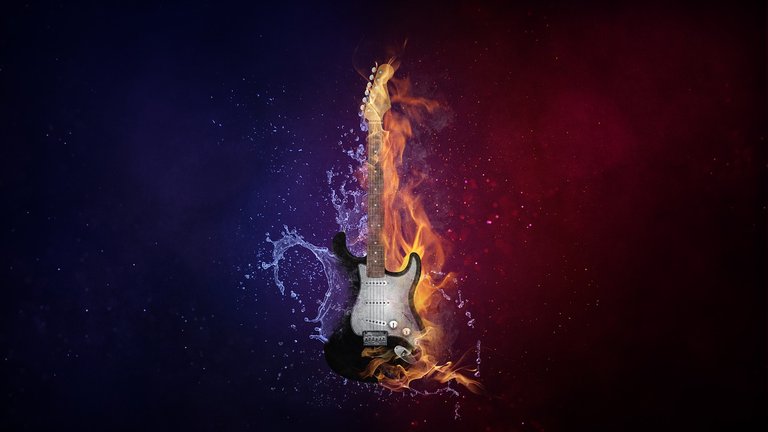Distortion and overdrive are the characteristic tones of electric guitars. A staple of many genres where electric guitars are used, the gritty or growling tone, which is what most people describe this tone as was initially achieved when amps were pushed to their limits and started clipping the signal.
Then manufacturers started making amps with Gain control to achieve this while still keeping the volume at reasonable levels. Then come a variety of effect pedals, but still, amps of today can produce a decent overdriven sound on their own without the need for a pedal.
Distortion, while used interchangeably with the term “overdrive,” is actually a more extreme form of overdrive.
In this article, we’ll learn:
- how to add distortion effect to electric guitars using just the amp
- distortion settings for tube amps
- distortion settings for standard (solid-state) amps
- settings for the guitar knobs and pickup selector for an optimal distorted sound
- some tips for distorted guitar playing so that the tone doesn’t get muddy and lost
How to Add Distortion to Electric Guitars using Amp Settings
Some decades back, guitarists figured out that if they pushed the volume past the amp’s limits, they could create a distorted sound. This became very common in the blues and rock genre, and manufacturers then started adding another control knob to do this while still having control over the volume.
Now, many amps have a Clean and an Overdrive channel and a switch to change between the two. The Overdrive channel, as the name suggests, offers the ability to overdrive or distort the sound of your guitar. Typically, each channel will have a Volume control (knob), and the other knobs, such as bass, treble, mid, etc., will be shared between the two channels. The Distortion channel will usually have a Gain knob, which we will be used to overdrive the signal.
Steps to add distortion using the Overdrive channel

- Turn the Volume and Gain knob all the way down on the Overdrive channel and press the Overdrive channel switch to activate it.
- Now turn the Volume to around a 9 o’clock position and set the Gain high to something like a 3 o’clock position.
- If you have separate EQ knobs, set the Bass at 12 o’clock, Mids at 9 o’clock position, and Treble at 3 o’clock. Or if your amp has a Tone knob instead, set it to a 3 o’clock position.
- Strum a note and see how it sounds; adjust the Gain and Volume according to your preference. You’ll see that you don’t necessarily have to set the volume high, as the Gain adds volume to the output.
The terms used for different controls on your amp may vary depending on the amp model and manufacturer.
- The Overdrive channel may be called the Distortion channel or OD channel.
- Gain control may be named Drive, Distortion or Overdrive
Steps to add distortion with Master Volume and Volume
In case your amp has a Master Volume and Volume control design, mostly found in tube amps. You’ll have to treat the Volume knob as the Gain and the Master Volume as the Volume. The Volume control internally controls the preamp volume, while the Master Volume controls the power amp volume.
By doing this, the signal can be distorted by overdriving the preamp while keeping the power amp volume safe for both the amp and our ears.
To add distortion using such amps, do the following:

- Start with setting the Bass knob at 12 o’clock, Mid at 9 o’clock, and Treble at 3 o’clock position. For amps with a Tone knob, set it to a 3 o’clock position.
- Set the Master Volume (or MV or Master) pretty low, around a 9 o’clock position.
- Set the Volume knob high, like you would the Gain knob, to something between 12 o’clock and 3 o’clock position.
- Strum a note and make Volume adjustments to how much distortion you want.
- Set the Master Volume to how loud you want the sound to be.
Other Controls
The settings for other controls depend mostly on your taste, music style, and genre. Most amps either have a Tone knob that sets the EQ or separate knobs for Bass, Mids, and Treble.
You can set these knobs according to your style of music, but as a general guideline, you would want the Bass to be quite high and the Treble even higher. This ensures that the distorted tone sounds and feels great without getting muddy or flat. But remember to play around with these settings until you get the best sound you like.
Many amps also have other effect controls like Chorus, Delay, and Reverb. You can also play around with these, but remember that too many effects generally don’t play well with distorted sounds. You can add a bit of chorus and some reverb, but too much might muddy up the tone.
Guitar Controls
As a general rule for a distorted sound, you can set the guitar’s Volume and Tone knobs at maximum. Again, you’re free to play around with the Tone knob. I would, however, recommend doing it only when you have already got a decent distorted sound from just the amp settings.
You can try the bridge pickup for an aggressive tone if your guitar has multiple pickups and a selector switch. This would be suitable for guitar solos. For rhythm guitars, you can try the neck pickup.
Guitar Techniques / Tips for a Better Distorted Sound
Many people think rock and metal music performers use extreme gain settings to achieve the distortion and fuzz, which isn’t exactly true. Live performers often favor distortion by increasing the volume to the extremes to create a more natural effect while keeping the gain fairly low. While for recorded music, the artists often have multiple distorted tracks at lower gain to beef up the final sound.
These techniques result in a cleaner distorted sound with little or no muddiness. Also, a lot depends on the guitarist and their playing style and techniques. You’ll have to employ certain specific techniques to get the best sound. The guitarist’s techniques are often underplayed by many who think that a high-end amp and gears are all it takes.
While high-end gear would certainly improve the sound output, it can’t compensate for the guitarist’s lack of techniques.
The following are some tips and techniques to practice for distorted guitar playing:
- Generally, use less distortion than you think you need.
- Practice muting. It works very well with distorted sounds.
- Keep unintentional/unwanted hits to the strings to a minimum.
- Use power chords instead of regular chords, especially for rhythm guitars. You play power chords by fretting only the root and fifth notes. The third note is what generally muddies the tone.
- Practice your timings and be aware of how many strings you’re playing at a time. Too many strings at once would usually muddy up the tone.
- A good quality but less-powered amp with extreme volumes will generally work better. The lesser power output would mean you are still at reasonable levels while cranking up full or near-full volumes.
Apart from these, a decent quality amp would certainly make a difference as they are more capable of maintaining clarity under heavy volume and gain. An overdrive/distortion pedal on a clean channel is also a great option once you have mastered the basics.
Electric Guitar Distortion – Related Questions
Do All Electric Guitars Have Distortion?
Distortion is not a characteristic or feature of a guitar. It is an effect that is achieved by shaping the tone or signal of the guitar by either the amp itself, an effect pedal, or both.
Distortion is the gritty, growling tone typical of many music styles, such as blues, rock, and metal.
Can You Add Distortion to an Acoustic Guitar?
Yes, if it is an acoustic-electric fitted with a microphone or magnetic pickup.
Acoustic (acoustic-electric) guitars use different pickups and different amps than electric guitars. The characteristic of this setup is that the final sound output remains as close as possible to the original, that is, the "acoustic" sound. On the other hand, electric guitars are meant for tone shaping/coloring; hence, the amp is essentially an extension of the guitar itself insomuch as the tone is concerned.
This is to say: an acoustic guitar hooked to an electric guitar amp would sound bad, which is because tone coloring is an inherent part of electric guitar amps. It doesn't play well to varying degrees with an acoustic guitar. On the other hand, an electric guitar would sound very thin and almost tinny with acoustic amps because they are meant to amplify the original signal without altering it much.
With that out of the way and to answer the question, it is possible to use distortion on an acoustic guitar by using an effect pedal and an acoustic guitar amp. The amp itself wouldn't be able to add distortion on its own, though. The result would vary greatly depending on the pedal, the guitar, the pickup, and the amp. And you would probably need some trial and error to get a good distorted sound out of it.
Summary
Adding distortion to an electric guitar with just the amp settings is not only possible, but it sounds excellent with a decent amp and good techniques. Remember to keep the Gain low and practice your techniques for a better sound. Remember, your attack or how you hit the strings while strumming and the force can affect how the tone sounds.
After learning the basics and being comfortable playing distorted sounds, you can go for the many distortion/overdrive pedals to get an even better sound with much more control over the different settings that make up an excellent distorted sound.


